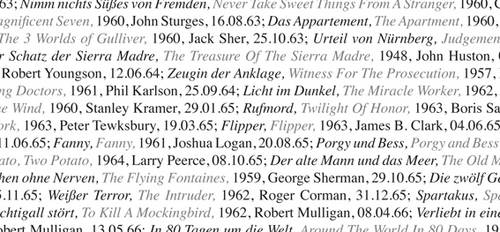Star of the GDR Screen: Class Enemy Nr. 1
Hollywood was a permanent guest of the GDR. Unannotated lists in the catalogue show which films were shown there, which is to say, which films had the state’s blessing (1): a surprising collection, given the ideological conflict between East and West.
Yet in the 1950s and 60s the state still hesitated to import US films, and not merely for political reasons. Licenses were expensive. However, when cinemas stayed empty following censorship of twelve DEFA films by the SED’s ‘Zentral Komitee’ during its XI plenary session in 1965, six American films were able to run in autumn of the same year, in addition to the spring-summer quota: which was more than ever before.
The marked increase in film imports after the start of the 70s was ultimately due to increasing Cold War detente – as well as to developments in Hollywood. Struggles for civil rights in the late 60s triggered a depression in the film industry. Hollywood no longer had its finger on society’s pulse and box-office receipts accordingly plummeted. Yet ‘New Hollywood’ was born of this crisis: films that addressed social issues and the excesses of political violence. Such plots were well suited to the GDR’s film policy. Yet even though the ‘New Hollywood’ era was of longer lasting effect in the GDR – where film releases were delayed by up to ten years – than in America, the 80s saw an increasing number of American blockbusters on the GDR’s screens. The insight prevailed that East Germans had a longing simply for entertainment. Socialist cinema alone could not fulfil that. Another reason was the ‘million strategy’ of the time, which aimed to pull at least one million visitors into certain films and thereby raise cash for the chronically under-funded East German film industry. That seemed to offer away out of its crisis.
Legislation demanding that 60% of films come from socialist countries and 40% from non-socialist countries was indeed complied with. Yet if one considers the number of films actually screened then inverse proportions apply. Dieter Drewitz reached this conclusion after counting up screenings that took place in Magdeburg between 1.1.1982 and 12.5.1983. The proportion of non-socialist films in this case was 65%; the proportion of American films alone was 23% (2).
American films were loved. Interesting scenes from them tended to vanish. Yet this was not due to censorship by the state. Projectionists obviously cut them out as collectors’ keepsakes (3).
Philipp Humpert
(1) The lists are formatted to show: Title in the GDR; Original title; Production year; Date of release in the GDR. The complete annotated lists are available on the Festival website.
(2) Interview on 2.9.2008 with Dieter Drewitz, co-founder of Magdeburg’s Filmklub Studio-Kino, and from 1980 to 1990 its director.
(3) Idem.


